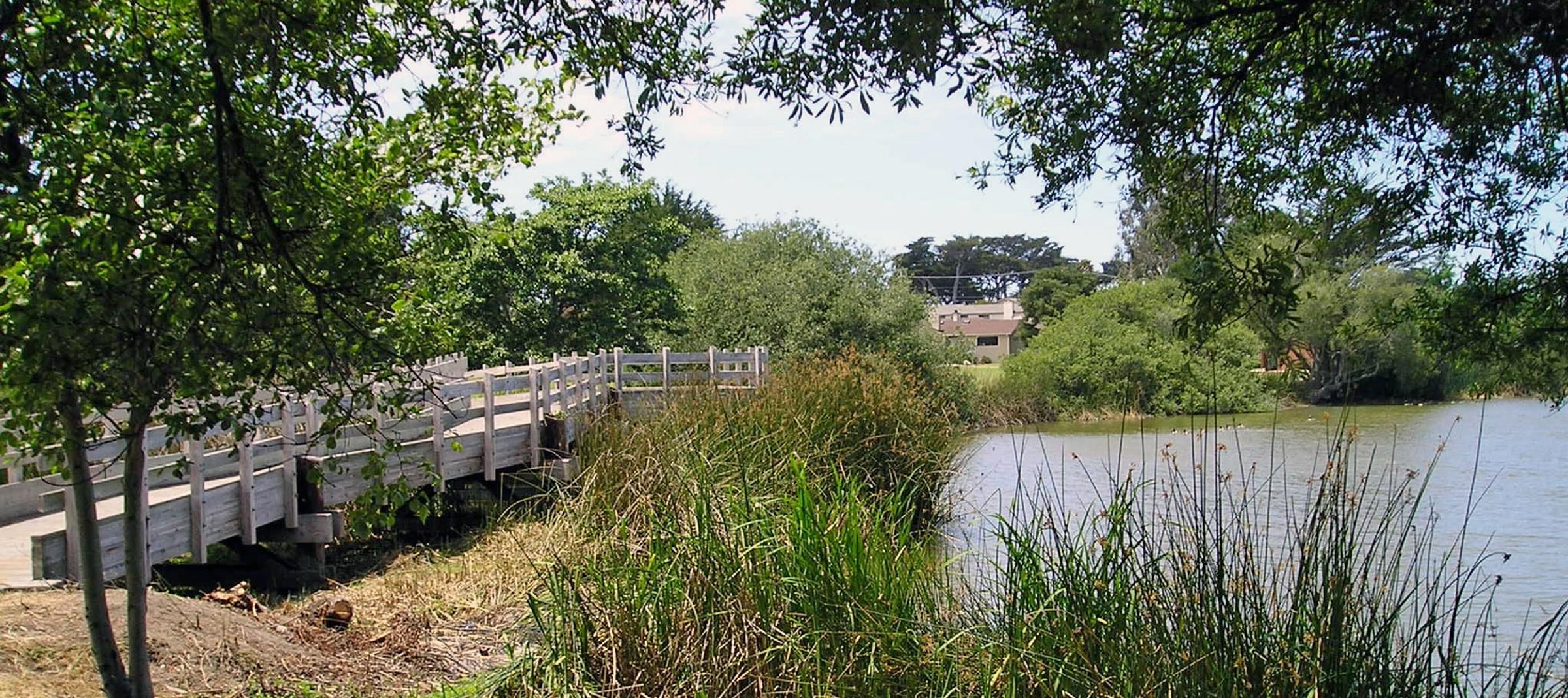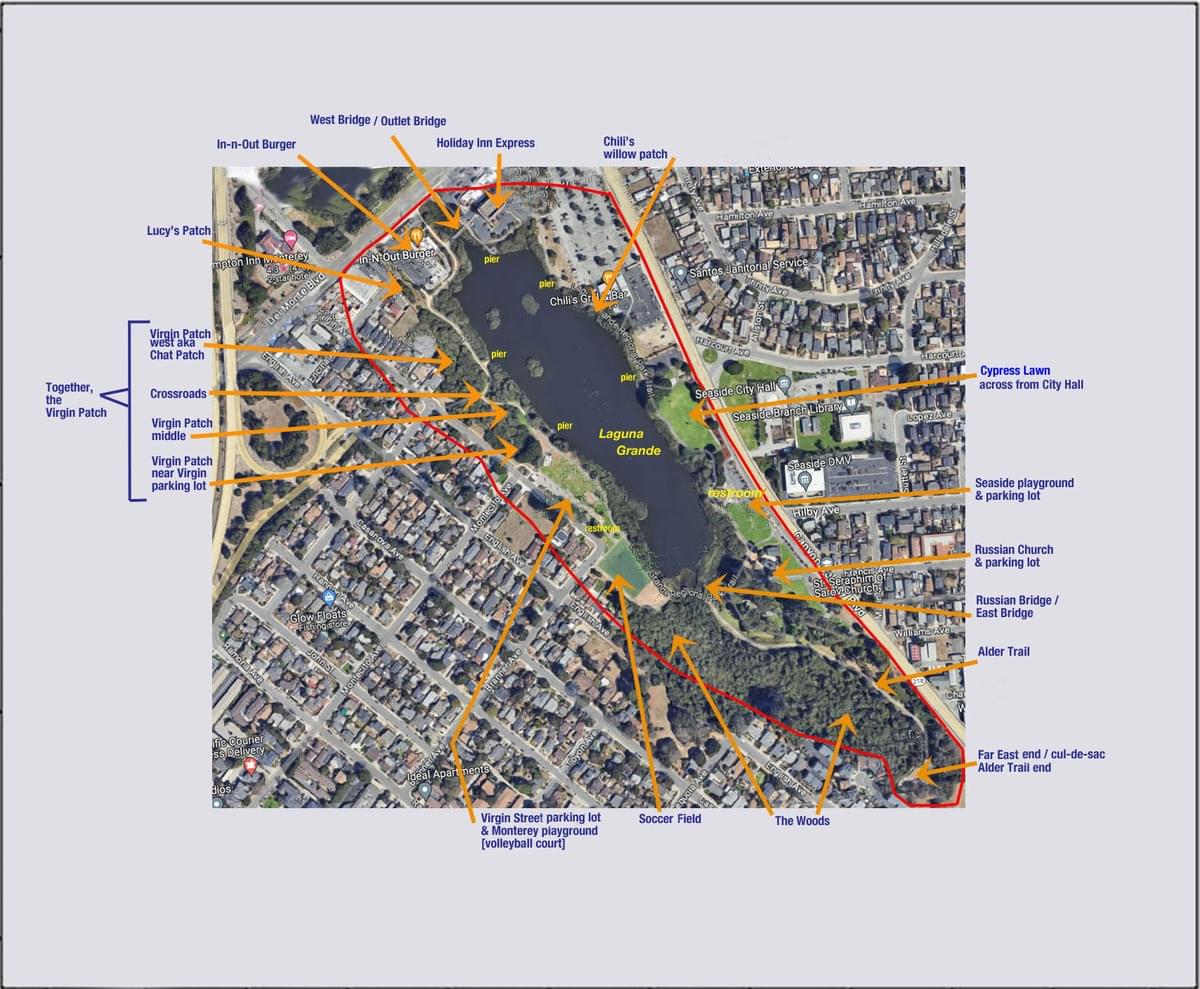Laguna Grande Park

Laguna Grande Park
Monterey, California 93940
City of Seaside & Monterey Peninsula Regional Park DistrictTips for Birding
Laguna Grande Park is among the most heavily birded locations in Monterey County. It is a good birding spot year-round but is most heavily birded during spring and (especially) fall migration. The focus is a rather shallow freshwater lake — Laguna Grande — that is on the border of the cities of Monterey (southwestern side) and Seaside (northeastern side), and each side is managed separately by those cities. There is a wide, paved, mile-long accessible Loop Trail around the freshwater lake, and a wide, gravel trail following a creek eastwards from the southeast end of the lake for another half-mile. The latter trail is know as the Alder Trail, which ends in a cul-de-sac and the "far east end" of the Park. All of the primary birding spots are connected by either the Loop Trail or the Alder Trail.
Laguna Grande lake is fringed with cattails. There are two important bridges that serve as primary landmarks for birders. At the east end, the Russian Bridge (named for the nearby Russian Orthodox Church in the eucalyptus grove, sometimes called "East Bridge"), includes a raised overlook over the southeast end of the lake. Depending on water level, there is typically a small sandbar here with Mallards, coots, Canada Geese, wing-drying Double-crested Cormorants, and sometimes a few gulls and, with luck, a shorebird. This is often a good first-place-to-visit or as a meeting place. At the west end, the West Bridge (or Outlet Bridge) crosses the lake's outlet channel between In-n-Out Burger and Holiday Inn Express. The outlet is full of reeds and is lined with willows on the south side.
There are various willow patches, sometimes mixed with planted conifers or eucalyptus, along the Loop Trail and the Alder Trail. The largest is known as the Virgin Patch, just northwest of the Virgin Avenue parking lot and extending to the In-n-Out Burger parking lot. The City of Monterey, working with the local Audubon Society, created a set of looping trails with shredded bark surface, through some of the willow patches, and thus subdividing the Virgin Patch into a series of smaller patches. Over time these have been named the "Chat patch" (in honor a Yellow-breasted Chat that wintered here two years), the "Lucy's patch" (for a wintering Lucy's Warbler in the past decade), and these trails converge at "the crossroads." You can locate these areas on the adjacent map of birding sites (click on the map to enlarge it; the red line is the Hotspot boundary).
There are also a series of 5 overlook piers at the western end of the lake. Birders can walk out on these overlooks to search for waterfowl, including ducks, herons, and gulls, or to view the three small islets (these "piers" as labeled in yellow on the map).
Walking eastwards on the south side of the lake from the Virgin Patch, there are more willow patches by the volleyball court and the soccer field, and a very large patch adjacent to the Russian Bridge. There are willows along the south side of the creek along the Alder Trail, and the namesake set of a dozen Alder trees about halfway to the "far east end" of the park. As one continues eastwards from the Russian Bridge, the habitat on the north side of the Alder Trail changes from eucalyptus, to an isolated reedy spot, to live oaks, and to blackberry brambles at various spots. At the cul-de-sac at the end, a set of cement stairs climb back up to Canyon Del Rey and Fremont Streets (with Safeway and a shopping center across from the end of the Park).
Walking westwards from the Russian Church/eucalyptus grove picnic area along the north side of the lake, there are willow patches near the Seaside playground, near Chili's restaurant, and near the Holiday Inn Express.
Laguna Grande Park is heavily used by local walkers, joggers, and parents with children; there are playgrounds in both Seaside and Monterey (the latter with a volleyball court), and there is a popular artificial-grass soccer field south of the Virgin Avenue playground. On some weekends there may be public events, some featuring barbecues (especially on the Seaside "cypress lawn" across from City Hall), and the Park can become very crowded. At times, there are miniature "speed boats" racing on the lake. Laguna Grande is definitely a multi-use public park, with habitat preservation attempted but not a high priority. Many locals avoid birding when the Park is very busy or noisy.
Unfortunately, there is also a "homeless/drug-user" problem, with (at times) many people apparently "living" and sleeping in the willows and chopping out sleeping places that have sometimes developed into "small villages." There is a place local birders call "The Woods," on the southeast end of the park, that is riddled with foot-paths, despite the "No Entry" signs lining the creek. Some of these people are drunk, drugged, and/or dangerous. This is a problem in urban parks throughout the United States, and can be an annoyance here. Local birders do not enter "The Woods" alone, and many of us don't enter the productive-looking habitat at all.
Birds of Interest
Laguna Grande is famed for several residents: a pair of Peregrine Falcon are often seen perched on the huge letters that read "Embassy Suites" on the high-rise hotel, and in 2020 they fledged 3 young from a nest-box atop that hotel. Great-tailed Grackles breed in the reeds at the west end, and are often seen around In-n-Out Burger. The reeds at the west end are also now a spot for Scaly-breasted Munia, non-natives that now breed locally. Double-crested Cormorants roost in two large pine trees when not standing on the sandbar at the east end. As you walk from west to east through the Park, you'll note changes in bird species as habitat changes. The grackles, vocalizing unseen rails, and American Goldfinch are typically at the west end, while you'll often not encounter Oak Titmouse or Hutton's Vireo until the east end. Pine Siskin, when present, tend to frequent the alders on the Alder Trail.
Canada Geese and Mallards breed here, but all other geese, ducks, rails, shorebirds, and terns are sporadic migrants or wanderers. Western and California Gull bathe on freshwater here year-round, but other gulls are much less common [however, a hybrid Western x Glaucous-winged Gull, called "George," has been wintering for 8+ years, and is often misidentified as "Herring Gull."). Green Heron and Black-crowned Night-Heron hide in the reeds, as do rails in winter, but you are lucky to see one. One or two pairs of Red-shouldered Hawk nest every year.
Most of the more that 250 species seen at Laguna Grande Park are migrants, either attracted to the lake or to the willow patches. Some very impressive rarities are among them, and some excellent vagrants have wintered here in willows, including Black-throated Green, Lucy's, Nashville, and Palm Warblers, plus Northern Waterthrush and Yellow-breasted Chat; a Sage Thrasher wintered in Pyracantha bushes in the In-n-Out parking lot. A Tropical Kingbird returned for multiple winters, often in cypresses around Cypress Lawn. These wintering rarities have brought hundreds of new birders to Laguna Grande.
The freshwater lake is shunned by salt-water waterbirds that are abundant on the ocean shore within sight of the lake, including Brandt's and Pelagic Cormorants, pelicans, scoters, scaup, loons, salt-water grebes, and terns. If you see any of these salt-water species on Laguna Grande, please document them (photos are best) and report them promptly in eBird (please give specific directions for rarities seen in this 13-acre Park).
Finally, please be aware of species that are not here. There is no chaparral or extensive understory habitat to support California Quail, California Thrasher, or Wrentit. Although these are common in appropriate habitat nearby, there is no corridor of habitat to bring them here. Yet, they are entered in eBird. There is a correlation between checklist reporting Wrentit but lacking all wrens; this is just sloppy data entry. Quail and thrashers can be mimicked by starlings. eBird filters cover huge areas and cannot warn of these local problems, but birders can learn to be more careful.
About this Location
Although Laguna Grande lake lies geographically from northwest to southeast, its inlet comes from the east, and its outlet is to the west —into Roberts Lake, across Del Monte Boulevard to the west. From a birding perspective it is easiest to think of it as running east to west — with the Pacific Ocean to the west, as is so familiar throughout Monterey County — that we'll write about the lake and the Park as if the major birding spots are either at the west end of the lake (towards the ocean) or at the east end of the lake (towards Del Rey Oaks).
There are multiple access points and parking lots around Laguna Grande Park. The two primary parking lots used by birders are the Virgin Avenue parking lot, on the Monterey side of the lake, and the "Russian Church" parking lot, along Canyon Del Rey on the Seaside portion of the park. Those driving north on Highway 1 from Monterey or Carmel, take the Del Monte Blvd. exit [#802B), turn right on English Ave., and then left on Branner, to the Virgin Avenue parking lot. Those driving south on Highway 1 from Marina or Moss Landing, exit at Canyon Del Rey in Seaside, continue east past Seaside City Hall, and turn right into a large parking lot / picnic area, in a huge eucalyptus grove, adjacent to a Russian Orthodox Church. Another, but smaller, parking lot is opposite the City Hall/Police Department facility, at the Seaside children's playground and restroom. Alternatively, there is more parking adjacent to Embassy Suites Hotel in a parking lot that extends to Chili's Bar & Grill restaurant. On Del Monte Avenue, there is limited parking on the south side of the In-n-Out Burger parking lot, next to a wall, that is sign-posted for use of Laguna Grande Park (keep far right to avoid the line for drive-up service at In-n-Out.) There is more parking adjacent to the Holiday Inn Express, on the side next to In-n-out.
Public restrooms are at the Seaside children's playground, and at the south end of the Virgin Avenue parking lot. Both are connected by the Loop Trail around the lake.
Laguna Grande Regional Park is located in the cities of Seaside and Monterey, and is managed separately by their respective cities and the Monterey Peninsula Regional Park District as a Joint Powers Authority (see Seaside's link, above). The Park is 13.33 acres, of which 80.5% are in Seaside and 19.5% are in Monterey. Historically, Laguna Grande was a coastal estuary (Laguna Del Rey) where a permanent creek (variously called Arroyo del Rey or Del Rey Creek) emptied into the estuary. The development of the City of Seaside included the construction of Del Monte Boulevard that divided the estuary, and impounded the wetlands into two freshwater lakes: Laguna Grande (east of Del Monte Blvd.) and Roberts Lake (to the west). Double-crested Cormorants, geese, gulls, terns, waders, and grackles routinely fly from Roberts Lake to Laguna Grande and back, but most of the resident birds at Laguna Grande, including rails, blackbirds, wrens, and sparrows appear to be limited in movement by the busy Del Monte Boulevard traffic.
Features
Restrooms on site
Wheelchair accessible trail
Entrance fee
Roadside viewing
Content from City of Seaside & Monterey Peninsula Regional Park District and Don Roberson & Rita Carratello
Last updated May 13, 2024
 Birding spots at Laguna Grande Park; click to enlarge
Birding spots at Laguna Grande Park; click to enlargeD. Roberson, R. Carratello, F. Hochstaedter